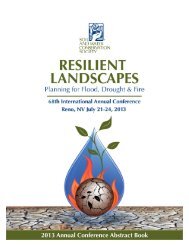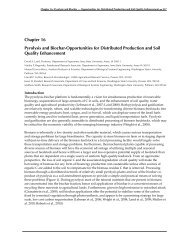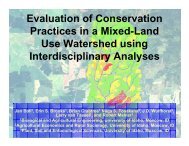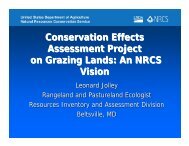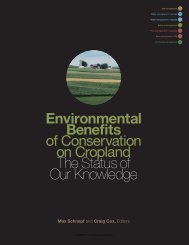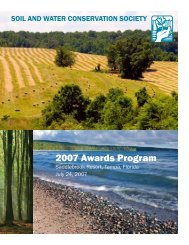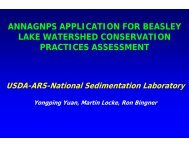Eilers, Warren - Soil and Water Conservation Society
Eilers, Warren - Soil and Water Conservation Society
Eilers, Warren - Soil and Water Conservation Society
Create successful ePaper yourself
Turn your PDF publications into a flip-book with our unique Google optimized e-Paper software.
Canada’s National Program to Assess<br />
Environmental Performance of Agriculture:<br />
National Agri-Environmental Health Analysis <strong>and</strong><br />
Reporting Program<br />
<strong>Warren</strong> <strong>Eilers</strong>, AEI Science Co-ordinator NAHARP
Content…<br />
• General introduction: importance of indicators for policy<br />
• The NAHARP Program<br />
Agri-Environmental Indicators<br />
Integrated Environmental / Economic Modelling<br />
Agri-Environmental Valuation<br />
• Concluding remarks
Environmental Sustainability in Agriculture<br />
• Requires production <strong>and</strong> processing of food <strong>and</strong> fibre in ways that<br />
protect or enhance the natural resources supporting agricultural<br />
production <strong>and</strong> that are compatible with surrounding natural systems<br />
<strong>and</strong> processes
Achieving environmental sustainability in agriculture<br />
has become more complex than ever…<br />
• Environmental issues are not new to agriculture, but public scrutiny<br />
of environmental costs of agricultural production has been<br />
increasing:<br />
<br />
<br />
<br />
<strong>Water</strong> quality issues, pesticide run-offs, fish kills<br />
Restrictions on intensive livestock operations<br />
Increased consumer awareness of environmental st<strong>and</strong>ards of food production<br />
• Environmentally sustainable production is increasingly an issue at<br />
an international level.<br />
<br />
key to demonstrate Canada is meeting emerging international st<strong>and</strong>ards to<br />
ensure continued market access.<br />
• Agriculture is also vulnerable to environmental problems<br />
<br />
<br />
<strong>Water</strong> shortages<br />
Invasive species
The role of government: Canada’s agriculture<br />
department’s environmental policy…<br />
• In Canada, much of the regulatory <strong>and</strong> decision powers on the<br />
environment rest with the provinces<br />
• The role of the national government is to work with industry <strong>and</strong><br />
provinces to help producers improve the environmental<br />
stewardship <strong>and</strong> sustainability of their sector<br />
• The m<strong>and</strong>ate of Agriculture Canada towards environmental<br />
sustainability of agriculture is therefore achieved through:<br />
Science <strong>and</strong> Innovation<br />
Programs that encourage on-farm action<br />
Measuring performance <strong>and</strong> reporting results
Information is needed to answer questions of<br />
environmental sustainability in agriculture<br />
• Objective <strong>and</strong> reliable information<br />
<br />
<br />
Often facing conflicting interests<br />
Cannot rely on information from interested parties<br />
• Historic approaches have focused on economic information, <strong>and</strong><br />
largely ignored environmental impacts<br />
<br />
Risk achieving economic goals at the expense of environmental objectives<br />
• Work is underway to develop <strong>and</strong> refine agri-environmental<br />
information <strong>and</strong> tools to integrate this information in decisionmaking<br />
<br />
The National Agri-Environmental Health Analysis <strong>and</strong> Reporting Program
The National Agri-Environmental Health Analysis <strong>and</strong><br />
Reporting Program (NAHARP)…<br />
• Objectives:<br />
<br />
<br />
<br />
To assess <strong>and</strong> report on the “end outcome” environmental performance of the<br />
agriculture sector in Canada, using science-based indicators<br />
To develop tools to integrate these indicators into policy development<br />
Actively contribute to international efforts (e.g. OECD) on the development of<br />
agri-environmental indicators
The National Agri-Environmental Health Analysis <strong>and</strong><br />
Reporting Program (NAHARP)…<br />
• Three components:<br />
<br />
<br />
<br />
Agri-Environmental Indicators: historical perspective on the agriculture sector’s<br />
environmental performance<br />
Integrated Economic/Environmental Modeling: evaluate existing policies <strong>and</strong><br />
programs relative to their combined economic <strong>and</strong> environmental performance,<br />
as well as to estimate or predict the economic <strong>and</strong> environmental impacts of<br />
proposed programs <strong>and</strong> policies<br />
Agri-Environmental Valuation: measure <strong>and</strong> compare benefits <strong>and</strong> costs of agrienvironmental<br />
performance – in dollars. Attaching a dollar value to bio-physical<br />
impacts can help in policy analysis <strong>and</strong> reporting.
AEIs: Identification of issues to address…<br />
Existing<br />
In development<br />
<strong>Soil</strong> Quality erosion<br />
soil organic carbon<br />
contamination by trace elements<br />
salinization<br />
<strong>Water</strong> Quality nitrogen pesticides pathogens<br />
phosphorous (Qc) phosphorous (RoC)<br />
Air Quality GHG ammonia <strong>and</strong> particulate matter<br />
Odour<br />
Biodiversity wildlife habitat wildlife damage<br />
soils biodiversity<br />
Invasive Alien Species<br />
Farm Management nitrogen use efficiency IPM adoption<br />
soil cover<br />
<strong>Water</strong> use efficiency - irrigation<br />
energy use efficiency<br />
Food <strong>and</strong> Beverage<br />
Industry<br />
GHG/Energy<br />
<strong>Water</strong> Use <strong>and</strong> Effluents<br />
Organic , wastes)
General approach for AEIs: Concept…<br />
INPUTS<br />
• Technology<br />
• <strong>Water</strong><br />
• Energy<br />
•Nutrients<br />
• Pesticides<br />
• L<strong>and</strong><br />
Quality & Quantity of<br />
Natural Resources<br />
<strong>Water</strong><br />
Air<br />
<strong>Soil</strong><br />
Biodiversity<br />
OUTPUTS<br />
• Crops & Livestock<br />
• Manure<br />
• Waste (pollution)<br />
- sediments<br />
- nutrient surplus<br />
- atmospheric<br />
emissions<br />
WHOLE FARM ENVIRONMENTAL MANAGEMENT
General approach for AEIs: Types of indicators…<br />
• Risk Indicators: estimate the likelihood of a potential environmental<br />
impact from farming activities<br />
• State Indicators: estimate the presence <strong>and</strong> degree of an impact or<br />
environmental service<br />
• Eco-efficiency Indicators: estimate of resource use efficiency
AEIs: Typical Data Sources…<br />
• AEI make as much use as possible of existing data sources<br />
• Data sources typically match the AEI reporting scale (regional<br />
provincial, national)<br />
<strong>Soil</strong> Information - <strong>Soil</strong> L<strong>and</strong>scapes of Canada (SLC) (1:1million)<br />
L<strong>and</strong> management <strong>and</strong> l<strong>and</strong>use practices - Census of Agriculture<br />
information reprocessed to SLC polygons (1981, 1986, 1991, 1996, 2001)<br />
Farm Environmental Management Survey<br />
Climate EC 30 yr normal values attached to Ecodistricts<br />
Other data sources as may be suitable to specific indicators or groups of<br />
indicators
AEIs Calculation…<br />
• Most indicators are calculated via scientifically based models<br />
Integrate biophysical information with l<strong>and</strong> use <strong>and</strong> management information<br />
Models are run at the SLC level <strong>and</strong> then aggregated up for reporting<br />
• Benefits<br />
Assessments at broad spatial scales<br />
Eliminates time lag between change in l<strong>and</strong> use/management <strong>and</strong> measurable<br />
impact<br />
Compatible with predictive policy modeling analysis<br />
Data acquisition costs are realistic<br />
• Use of Geographic Information System (GIS):<br />
framework for calculating <strong>and</strong> reporting indicators<br />
allows integration with other information<br />
improve delivery of information (maps)
AEI Calculations: National Ecological Framework…<br />
Ecoregion<br />
Ecozone<br />
Provincial / National<br />
AEI Reporting<br />
Ecodistrict<br />
<strong>Soil</strong> L<strong>and</strong>scape<br />
of Canada<br />
AEI Calculations
AEIs: Interpreting Results…<br />
Classes<br />
Meaning<br />
Possible Implication<br />
1 - Very low<br />
risk<br />
2 - Low risk<br />
3 – Moderate<br />
Risk<br />
4 - High risk<br />
5 - Very high<br />
risk<br />
In general this level of risk is negligible.<br />
Agri-environmental health likely to be<br />
maintained or enhanced over time.<br />
In many cases this level of risk may be<br />
acceptable.<br />
Agri-environmental health at low risk of<br />
being significantly degraded.<br />
Awareness of the situation is important.<br />
Agri-environmental health is at moderate<br />
risk of being significantly degraded.<br />
Heightened concern is warranted.<br />
Agri-environmental health at high risk of<br />
being significantly degraded.<br />
Immediate attention is required. Under<br />
current conditions, agri-environmental<br />
health is at very high risk of being<br />
significantly degraded.<br />
Detailed analysis is warranted to underst<strong>and</strong> the<br />
factors that contributed to this rating. Potential may<br />
exist to export policy <strong>and</strong> program approaches to<br />
areas of higher risk.<br />
Continued adoption of BMPs may improve situation<br />
in some areas. Specific (policy or program) actions<br />
not necessarily warranted.<br />
The trend (+ or -) needs to be assessed. Attention<br />
should be directed locally to promote adoption of<br />
BMPs in order to better match the limitations of the<br />
biophysical resource <strong>and</strong> reduce this risk.<br />
A local assessment is probably warranted.<br />
Additional efforts <strong>and</strong> targeted actions are likely<br />
needed locally to better match management practices<br />
to the limitations of the biophysical resources.<br />
A thorough local assessment is warranted. Concrete<br />
<strong>and</strong> targeted actions are likely needed locally to<br />
better match management practices to the limitations<br />
of the biophysical resources. It may be necessary to<br />
consider alternate l<strong>and</strong> uses to reduce the risk.
The National Agri-Environmental Health Analysis <strong>and</strong><br />
Reporting Program (NAHARP)…<br />
• Three components:<br />
<br />
<br />
<br />
Agri-Environmental Indicators: historical perspective on the agriculture sector’s<br />
environmental performance<br />
Integrated Economic/Environmental Modeling: evaluate existing policies <strong>and</strong><br />
programs relative to their combined economic <strong>and</strong> environmental performance,<br />
as well as to estimate or predict the economic <strong>and</strong> environmental impacts of<br />
proposed programs <strong>and</strong> policies<br />
Agri-Environmental Valuation: measure <strong>and</strong> compare benefits <strong>and</strong> costs of agrienvironmental<br />
performance – in dollars. Attaching a dollar value to bio-physical<br />
impacts can help in policy analysis <strong>and</strong> reporting.
Integrated Economic-Environmental Modeling…<br />
• Multidisciplinary approach<br />
Bring quantitative, science-based information into the policy debate<br />
Enable forward looking analysis to evaluate policy options <strong>and</strong> scenarios<br />
• Integrate economic model with environmental models<br />
Policy Model : CRAM (Canadian Regional Agricultural Model)<br />
Biophysical Models : Agri-Environmental Indicators<br />
• Assess various farm management scenarios relative to a<br />
Business as Usual (BAU) baseline<br />
• Generate information on<br />
L<strong>and</strong> use change for major activities<br />
Area of major crops<br />
Summerfallow <strong>and</strong> tillage practices<br />
Livestock numbers<br />
Economic impact on both producers <strong>and</strong> consumers
The National Agri-Environmental Health Analysis <strong>and</strong><br />
Reporting Program (NAHARP)…<br />
• Three components:<br />
<br />
<br />
<br />
Agri-Environmental Indicators: historical perspective on the agriculture sector’s<br />
environmental performance<br />
Integrated Economic/Environmental Modeling: evaluate existing policies <strong>and</strong><br />
programs relative to their combined economic <strong>and</strong> environmental performance,<br />
as well as to estimate or predict the economic <strong>and</strong> environmental impacts of<br />
proposed programs <strong>and</strong> policies<br />
Agri-Environmental Valuation: measure <strong>and</strong> compare benefits <strong>and</strong> costs of agrienvironmental<br />
performance – in dollars. Attaching a dollar value to bio-physical<br />
impacts can help in policy analysis <strong>and</strong> reporting.
Agri-Environmental Valuation…<br />
• Why do monetary valuation?<br />
First motivation is to inform decision makers re. Implications of their actions on<br />
the environmental goods <strong>and</strong> services<br />
Politicians <strong>and</strong> many policy makers pay attention to things that are quantified<br />
<strong>and</strong>/or presented in monetary values (for the sake of bringing comparability)<br />
Help select better policies based on a more comprehensive analysis (including<br />
benefits to society <strong>and</strong> / or damages done to natural ecosystems)
Concluding remarks: limitations to this work…<br />
• Incomplete <strong>and</strong> still evolving scientific knowledge of the interaction of<br />
agriculture with the environment<br />
• Uncertainty regarding the precision or accuracy of indicator model estimates<br />
Limitations concerning the scope of agricultural practices captured by<br />
indicator models (reliability is unknown, uncertainty not quantified)<br />
• Data availability poses constraints in modeling<br />
Scaling Issues – Indicators based on models validated at field scale; scaling<br />
to National, Provincial <strong>and</strong> Regional levels subject to some uncertainty<br />
• Inconsistency between the spatial basis of indicator models <strong>and</strong> economic<br />
models, which currently precludes setting environmental targets at subprovincial<br />
levels.
Concluding remarks: lessons learned…<br />
• Agri-Environmental Indicators can…<br />
facilitate the inclusion of measurable environmental goals <strong>and</strong> targets in policies<br />
provide a means of evaluating policies effectiveness <strong>and</strong> to report on progress<br />
help target policy implementation at areas <strong>and</strong> environmental issues most in need<br />
of attention<br />
• Integrated economic-environmental analysis can…<br />
help estimate alternative policy outcomes <strong>and</strong> levels of effort needed to achieve<br />
these<br />
provide information for setting meaningful <strong>and</strong> achievable targets<br />
• Important aspects to consider for these types of purposes…<br />
indicators must be amenable to modeling<br />
indicators <strong>and</strong> modeling systems must be based on sound science, adequate <strong>and</strong><br />
valid data, to be accepted by stakeholders<br />
a long-term institutional commitment to the use of indicators <strong>and</strong> their ongoing<br />
improvement is highly desirable
For more information…<br />
• Agri-Environmental Indicator Report (2005)<br />
www.agr.gc.ca/env/naharp-pnarsa<br />
• Quantitative Analysis of the Impact of Agricultural<br />
Management Strategies on Environmental Indicators<br />
http://www.agr.gc.ca/spb/rad-dra/publications/isie/ise_e.pdf
Thank You !



